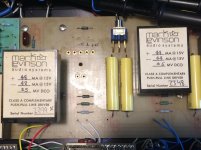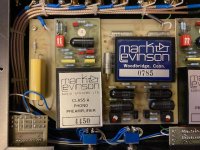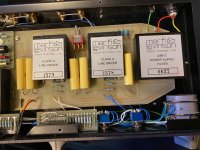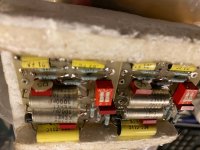Just looked it up, my MC has .5mV and I have a total of 58dB (with a 1:10 step up (20dB)), so 66dB would give about the same level with 0.25mV.
So my recommendation would be:
switch 1 open
switch 2 closed
So my recommendation would be:
switch 1 open
switch 2 closed
Just looked it up, my MC has .5mV and I have a total of 58dB (with a 1:10 step up (20dB)), so 66dB would give about the same level with 0.25mV.
So my recommendation would be:
switch 1 open
switch 2 closed
Thank you VERY MUCH!! I will try this out and let you know!
Kind regards and again thank you for your help
Hi again everyone!
I've just received a pair of Mcintosh MC30 monoblocks to match the JC-2 and I'm having trouble finding out which of the 2 switch positions should I choose for the mac, I'm quite ignorant on this matter.
According to ML "When switched to the right (factory set position) the line outputs are AC coupled for driving direct coupled power amplifiers. When switched to the left, the line outputs are direct coupled for friving AC coupled amplifiers." and MC30 has Unity-Coupled M-150B transformers.
Does anyone here know which position should the swith be?
Thanks!
I've just received a pair of Mcintosh MC30 monoblocks to match the JC-2 and I'm having trouble finding out which of the 2 switch positions should I choose for the mac, I'm quite ignorant on this matter.
According to ML "When switched to the right (factory set position) the line outputs are AC coupled for driving direct coupled power amplifiers. When switched to the left, the line outputs are direct coupled for friving AC coupled amplifiers." and MC30 has Unity-Coupled M-150B transformers.
Does anyone here know which position should the swith be?
Thanks!
Hello everyone,
I hope this is the right thread for my question.
I have just acquired a first-generation ML JC-2, with a defective line output amplifier module.
Otherwise in good condition.
Could someone be so kind and point me toward directions where to find replacement modules? Or upgraded modules of some sort?
Is there someone out there who does good clones or upgrades?
That would be amazing, as I would love to make this unit play again. Thanks so much.
Attached a photo & link to the faulty module in question.
Dropbox - ML-JC-2.jpg - Simplify your life
I hope this is the right thread for my question.
I have just acquired a first-generation ML JC-2, with a defective line output amplifier module.
Otherwise in good condition.
Could someone be so kind and point me toward directions where to find replacement modules? Or upgraded modules of some sort?
Is there someone out there who does good clones or upgrades?
That would be amazing, as I would love to make this unit play again. Thanks so much.
Attached a photo & link to the faulty module in question.
Dropbox - ML-JC-2.jpg - Simplify your life
Attachments
Last edited:
Hello everyone,
I hope this is the right thread for my question.
I have just acquired a first-generation ML JC-2, with a defective line output amplifier module.
Otherwise in good condition.
Could someone be so kind and point me toward directions where to find replacement modules? Or upgraded modules of some sort?
Is there someone out there who does good clones or upgrades?
That would be amazing, as I would love to make this unit play again. Thanks so much.
Attached a photo & link to the faulty module in question.
Dropbox - ML-JC-2.jpg - Simplify your life
Hi! I have found these from Japan. I haven´t try them myself but I did see some JC-2 with this modules installed on Hifido. Once I wrote them and they answered fast, maybe it is worth a try, they have Line and Phono modules.
Good luck!
DOA016 for Mark Levinson
ML-1 phono and JC-1-SM
Attached are four pictures from the inside of my ML-1. As seen the installed modules are labelled "A". My other modules are labelled "A4E" and "D5".
I have always believed the block between the two phono sections has been the +/-13V regulator for the phono modules. Now I understand this is the JC-1-SM. This has escaped me all these yars.
My ML-1 has been in storage for years now, but still this is of great interrest.
Regds
Attached are four pictures from the inside of my ML-1. As seen the installed modules are labelled "A". My other modules are labelled "A4E" and "D5".
I have always believed the block between the two phono sections has been the +/-13V regulator for the phono modules. Now I understand this is the JC-1-SM. This has escaped me all these yars.
My ML-1 has been in storage for years now, but still this is of great interrest.
Regds
Attachments
Attached are four pictures from the inside of my ML-1. As seen the installed modules are labelled "A". My other modules are labelled "A4E" and "D5".
I have always believed the block between the two phono sections has been the +/-13V regulator for the phono modules. Now I understand this is the JC-1-SM. This has escaped me all these yars.
My ML-1 has been in storage for years now, but still this is of great interrest.
Regds
RK that’s right, it is the MC step up transformer and from the pictures you uploaded I can tell my modules are the D5, which means that I can get 60db. I still consider the possibility of adding a step up just to see how much natural the sound can get
Which preamp are you currently using? If I had a ML1 I wouldn’t store it for too long hehe
Regards
I am using the DIY version of the Nelson Pass B-1 (0 dB gain).
I have try the ML-1 again.
I never studied the concept of the plug in modules too well. Are there any link to their pin-out? It should be fairly easy to “roll your own”.
Best regards
I have try the ML-1 again.
I never studied the concept of the plug in modules too well. Are there any link to their pin-out? It should be fairly easy to “roll your own”.
Best regards
From the test of the Levinson JC-2 in “Audio Magazine” April 1976: https://worldradiohistory.com/Archive-All-Audio/Archive-Audio/70s/Audio-1976-04.pdf
A. Normal phono: 32.5 dB gain at 1 kHz. Uses system A plug-in equalizers and is for regular magnetic cartridges.
B. Normal phono: 30 dB gain at 1 kHz. Uses system B plug-in equalizers and is for high output magnetic cartridges.
C. Special Phono Equalization: For. B&K test records.
D. Moving-Coil Phono: 60 dB gain at 1 kHz. Uses JC-1SM pre-preamp with phono amplifiers. Uses D or D1 equalizers.
E. Strain Gauge: Provides equalization and d.c. excitation for certain strain gauge pickups.
F. Flat Response: Provides for flat gain of front end for microphone and other flat-gain applications.
D is flat and D1 rolls off above 7 kHz.
A. Normal phono: 32.5 dB gain at 1 kHz. Uses system A plug-in equalizers and is for regular magnetic cartridges.
B. Normal phono: 30 dB gain at 1 kHz. Uses system B plug-in equalizers and is for high output magnetic cartridges.
C. Special Phono Equalization: For. B&K test records.
D. Moving-Coil Phono: 60 dB gain at 1 kHz. Uses JC-1SM pre-preamp with phono amplifiers. Uses D or D1 equalizers.
E. Strain Gauge: Provides equalization and d.c. excitation for certain strain gauge pickups.
F. Flat Response: Provides for flat gain of front end for microphone and other flat-gain applications.
D is flat and D1 rolls off above 7 kHz.
From the test of the Levinson JC-2 in “Audio Magazine” April 1976: https://worldradiohistory.com/Archive-All-Audio/Archive-Audio/70s/Audio-1976-04.pdf
A. Normal phono: 32.5 dB gain at 1 kHz. Uses system A plug-in equalizers and is for regular magnetic cartridges.
B. Normal phono: 30 dB gain at 1 kHz. Uses system B plug-in equalizers and is for high output magnetic cartridges.
C. Special Phono Equalization: For. B&K test records.
D. Moving-Coil Phono: 60 dB gain at 1 kHz. Uses JC-1SM pre-preamp with phono amplifiers. Uses D or D1 equalizers.
E. Strain Gauge: Provides equalization and d.c. excitation for certain strain gauge pickups.
F. Flat Response: Provides for flat gain of front end for microphone and other flat-gain applications.
D is flat and D1 rolls off above 7 kHz.
Thanks for that info and the pdf in particular! It has very useful information! It is a very nice preamp, the only downside I find is the modules and power supply, the former are very difficult to find and quite pricey, and the latter is almost impossible to find and very expensive
Maybe this information exist elsewhere, but it would have been nice if we could sort out all the different equalization boards (A, B, D and so on, has e.g. E ever existed?) and list them up, like this list I found at the Audio Magazine test report.
Pin-out would be nice also.
Pin-out would be nice also.
Maybe this information exist elsewhere, but it would have been nice if we could sort out all the different equalization boards (A, B, D and so on, has e.g. E ever existed?) and list them up, like this list I found at the Audio Magazine test report.
Pin-out would be nice also.
Yes indeed. In my case I have the D5 modules and the Regular phono inputs, same as you. I you have the chance to swipe and test with the other modules options that you own would be great, I don’t think many people have those in stock these days
What do you mean with pin out? Sorry I don’t understand
Ah. I can check that with the pin-out. I mean what pins on these modules are in, out, ground and so on. But I can check my own modules and post it later on.
Yes, I intend to try the ML-1 one of these days, and I can plug in the D module I have. Must change the phono cable from the turntable as I have a balanced system these days. Later....
Yes, I intend to try the ML-1 one of these days, and I can plug in the D module I have. Must change the phono cable from the turntable as I have a balanced system these days. Later....
RK that’s right, it is the MC step up transformer...
It is an active circuit not a transformer.
JC-1-SM
Correct, it is an active plug-in gain block. Probably quite similar to the stand alone JC-1.
Correct, it is an active plug-in gain block. Probably quite similar to the stand alone JC-1.
It is an active circuit not a transformer.
Oh I wasn’t aware of that. What are the differences between both?
A transformer is a passive device. The signal transformer for a moving coil step up design are conceptually similar to the transformer in a power supply, but much smaller.
The active circuit is built from bipolar transistors, JFETs, and/or tubes. The JC-1-SM is built from bipolar transistors as active devices.
The active circuit is built from bipolar transistors, JFETs, and/or tubes. The JC-1-SM is built from bipolar transistors as active devices.
It is an active circuit not a transformer.
Thanks! Would then a passive device have/make less noise ? In theory of course
And then in the case of this preamp, if I wanted to use a SUT then should I remove the JC-1-SM altogether right?
Probably. See this nice text, with links to e.g. Jensen transformers, Lundahl etc.
mc step-up transformers explained
Regarding the JC-1-SM I am not sure, but maybe it is out of the circuit when the A plug-ins are used instead of the D types?
mc step-up transformers explained
Regarding the JC-1-SM I am not sure, but maybe it is out of the circuit when the A plug-ins are used instead of the D types?
Last edited:
I checked my ML-1 now, and when both the JC-1-SM and the A-type equalizers are plugged in, the JC-1-SM is out of the circuit by its output pin going to an unused pin on the A-equalizer. Further, the A-equalizer provides a resistor (measured to 10k) between the JC-1-SM’s input pin and its “third pin” (between its input and output). I do not know it this might be the minus input or what. It is not shown on the available JC-1DC schematics.
While the JC-2 supposedly could be used with strain gauge pick-ups, I do not see this possibility with the ML-1. The reason being that these pick-up types are in need of a bias current. The old Panasonic strain gauges requires 4 mA. Anyway, neither +15V nor -15V are connected to the equalizer board. But this should be possible for the eager DIYer by taking the required voltages from the JC-1-SM position (obviously the JC-1-SM has to be removed).
While the JC-2 supposedly could be used with strain gauge pick-ups, I do not see this possibility with the ML-1. The reason being that these pick-up types are in need of a bias current. The old Panasonic strain gauges requires 4 mA. Anyway, neither +15V nor -15V are connected to the equalizer board. But this should be possible for the eager DIYer by taking the required voltages from the JC-1-SM position (obviously the JC-1-SM has to be removed).
- Home
- Amplifiers
- Solid State
- Can someone help with Mark Levinson JC-2?




